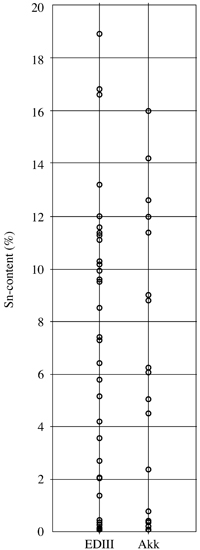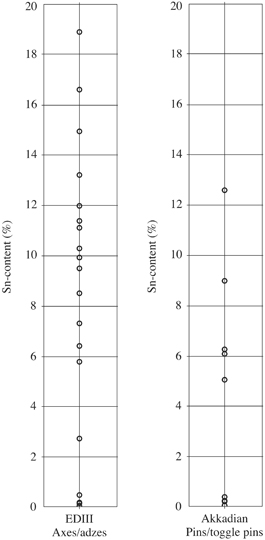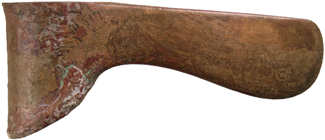Tin

Scatterplot for Tin (EDIII v. Akk)

Scatterplot for Tin (EDIII shafthole adzes and Akk pins)
Currently it is believed that the alloying of tin with copper to make bronze appears for the first time in Mesopotamia around 2750 B.C. (see Kish). We lack Ur artifacts from that crucial innovative period, but the three artifacts attributed here to the earlier Jamdat Nasr/EDI phase (circa 3200–2900 B.C.) all have an Sn-content less than 0.018%, whereas 22 out of the 49 artifacts attributed to the ED III phase (2700–2330 B.C.) have an Sn-content of more than 0.5%. Similarly, 24 out of 39 artifacts attributed to the subsequent Akkadian phase (2330–2100 B.C.) have an Sn-content of more than 0.5%.
ED III range: <0.010%–18.9% (n=48)
Highest Sn-level: Shafthole adze (inv. 31-17-186)
Akkadian range: <0.011%–16.0% (n=36)
Highest Sn-level: Spatula (inv. 30-12-321)
Among tools and weapons, there is little or no evidence that tin was being added deliberately for any functional benefit. For example, among the 20 shafthole axes and adzes from the ED III phase, the Sn-content ranges from less than 0.024% to 18.9%; and among the 5 daggers from that phase, the Sn-content ranges from less than 0.012% to 9.6%. Similarly, for the Akkadian phase, among the 6 shafthole axes and adzes, the Sn-content ranges from <0.012% to 4.6%; and among the 8 daggers, the Sn-content ranges from less than 0.013% to 12.0%. Yet, to create a tool or a weapon with any significant toughness would require an Sn-content of about 4% (Northover 1989).
Among Ur’s numerous decorative pins, there is perhaps some evidence that during the Akkadian phase tin was being added deliberately for an aesthetic purpose. The Sn-content of 12.6% in two pins—the toggle pin and the simple pin (inv. B16954 and B17495, respectively)—would give their bronze a golden hue when freshly cast (Chase 1983); and four other pins have an Sn-content >5% that would have made them appear noticeably different from reddish, tin-free copper ones.
The absence of bronzes with an Sn-content that lies between about 0.5% and 2.4% suggests that the latter level is a marker for the deliberate addition of tin for some purpose. What that purpose might be, however, remains obscure. Even trace levels of tin in copper ores is rare, so the occasional instances among Ur bronzes—in fact, 13 of the 87 artifacts studied; thus, 15%—where a Sn-content lies in the range of 0.1% to 0.5% might suggest that recycling of scrap bronze, and some mixing of that bronze with basic copper stock. If such an interpretation is valid, it should be noted that it was more common at the contemporary site of Kish (see Kish).

31-17-186: Shafthole adze
As, 0.33%; Sn, 18.9%; Ni. 1.23%
